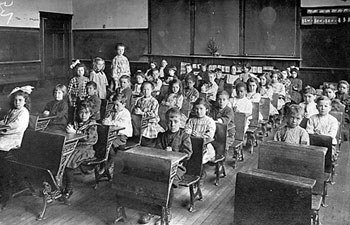The Schoolroom continued
Because many of America's earliest schools were established for religious reasons where children learned to read the Bible, many New England schools were once religious meetinghouses. Some communities used whatever space available, makeshift or otherwise, for children to gather and learn.
Until the late 1800s there was no electricity, central heating or indoor plumbing in most schools. Potbellied stoves kept most rooms warm, outhouses were common and school could only be held during daylight hours. Some were forced to close in winter because of the the lack of heat and limited daylight.
Furnishings were generally sparse. Children sat on pine or oak wooden benches or on pew-like seats attached to the box-like desk in front of them. In the earliest days, desks and benches were built on raised platforms upon packed dirt floors. The schoolmaster's desk often had a place to rest a birch-rod or hickory stick pointer, which sometimes doubled as a switch for disciplinary means.

Martha's Vineyard Museum